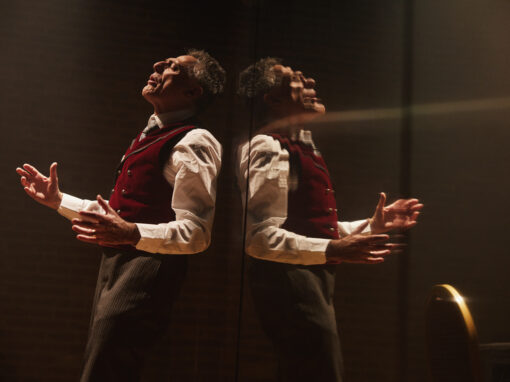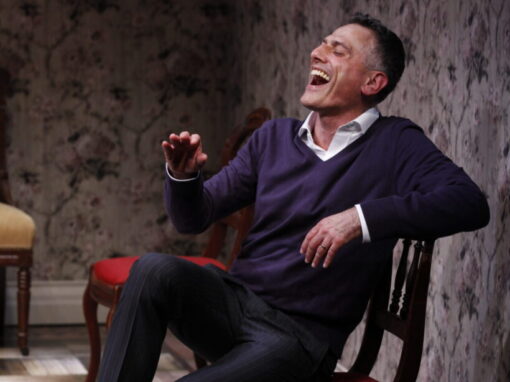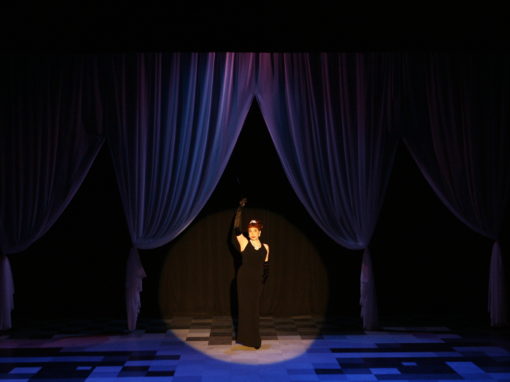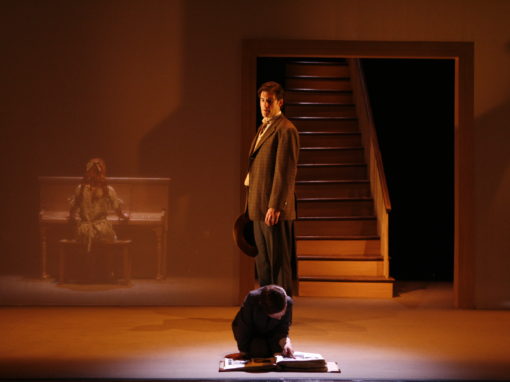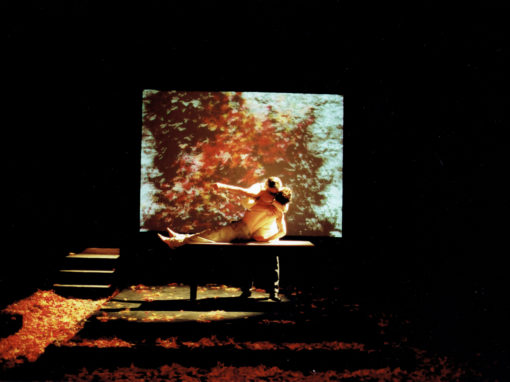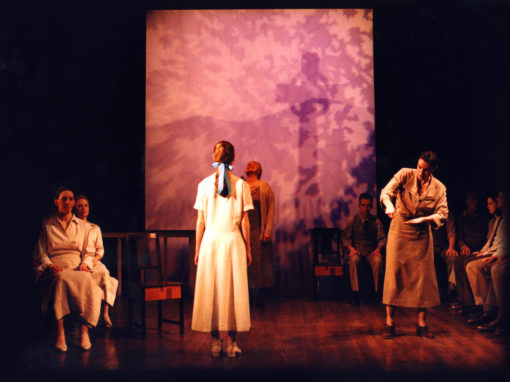Micro Meets Macro // by Sandra Goldmark
Scenic designer Sandra Goldmark contemplates the lifespan of each choice in her designs.
What are we making, anyway?
Designers have to have a built-in zoom function. They must be able to look at a little detail – a button, a stripe – and understand how it will contribute to the whole image. And they have to be able to zoom out and take in the whole stage picture, the colors, the groups of actors, the little imaginary universe in all its sparkling intensity. It’s a wonderful ability, and very useful for making worlds onstage.
I have designed twelve shows with Transport Group, starting with cul-de-sac in 2006. Together, we made twelve little worlds out of bungee cords and balsa wood and every material in between. Somewhere around the sixth, The Boys in the Band, my built-in zoom function started going haywire; I began to be able to zoom much farther out, to see much more. It may have been because between Crossing Brooklyn and Almost, Maine I made something in addition to scenery: two children, to be specific. Maybe the hormones – the raw powerful love that pumped through my body when pregnant or nursing – made me able to see more, like a superhero in a comic book but without the cape or the abs.
I began to be able to zoom way, way out – not just to see the stage picture, but all the shows, one after the other, sped up. I could see all of the couches and walls and floors and lamps and props moving into the theatre, getting assembled and painted and lovingly positioned just so. I could see the actors moving between those objects, saying their lines, sometimes making us cry or laugh.
I could also see the other people in the city – in the supermarket, reaching for the bread and the yogurt, on the street opening their umbrellas. Or in their apartments, surrounded by little worlds of stuff just like the ones I made onstage. Zoom out a bit farther and I could see all those objects being made, packaged, shipped, opened, assembled. Machines harvesting and people assembling. Boats and trucks crisscrossing the globe, full full full. I could even see the power and energy of the earth pumping, like milk, into the earth and the trees, flowing through the wood and stone we fed into our factories and trucks, into our theatres and homes.
And of course, I could see all that stuff when the show was over, moving back out of the theatre and into the dumpster and into a big hole in the ground, usually. Maybe sometimes into a dusty warehouse – just a delay, really.
At home I rinsed my yogurt cups and brought my canvas bags to the supermarket. But at work, in every detail I saw that horrifying big picture. In every button, every stripe, every piece of lauan cut down from a virgin forest on the other side of the globe, I saw how I was sucking nutrients from the earth for a brief flash of entertainment, or maybe sometimes art if we were lucky. I was just like most of the other little creatures I saw crawling around way down below. And I knew that it wasn’t even balanced – I was part of the 5% of those crawling creatures that consume 25% of the earth’s resources.
I started asking myself, what was I making, really? Scenery? Plays? Landfill? Or nothing at all… I was just part of this churning hive of humanity slowly transforming the earth into stuff – the Amazon into Amazon.
I felt, for a while, that I had to quit. Or maybe I could become a playwright or a director and make plays about recycling, or something. (Luckily, I quickly realized that no one would come see a play about recycling, and that I didn’t actually want to write, or direct plays.) I loved making worlds with objects. I just wanted to make them in a way that wasn’t destructive and wasteful.
It’s hard to use words like destructive and wasteful about shows that I loved, made with people I love. Some of the best work I had ever done was with Transport Group. But it’s the truth: along with the beauty, the laughter, the artistic triumphs (and the occasional clunker), I saw waste and injustice and extraction and emissions and, most of all, an untenable future for those two kids I had made. It was all around me, in the very scenery I made.
It didn’t seem worth it.
I started changing the way I designed and calling for change in the industry. I felt frustrated and impatient with an industry that purported to care about changing the world for the better or at least holding up a mirror to it, but that was inexplicably and inexcusably silent about the massive global train wreck of climate change.
I found purpose in pushing for change, and I found new superpowers and new projects. But I still wasn’t sure what I thought about this thing I had been doing for so many years – making worlds onstage.
Funnily enough, the puzzle was solved, partially at least, by another TG show, one I didn’t design. I Remember Mama was in The Gym at Judson, a space where I had helped create Niagara Falls for Queen of the Mist and a North Woods winter for Almost, Maine. The Gym is an unpretentious but elegant space with cream-colored brick walls and a deep history in the arts, from Trisha Brown to Bread and Puppet to TG’s Lysistrata Jones. I won’t describe I Remember Mama; readers can learn more from Barbara Barrie’s beautiful account of this family story cast entirely with women over the age of 70. R. Lee Kennedy had installed a grid of industrial lamps over the whole space, and the light flowed over actors and audience alike, in rolling waves.
I could feel, through those actors and those lights overhead, a connection to the women onstage. I could feel the connection to the women and children and men in the story, and to the women and children and men in my own life. I left in tears.
Zooming out from The Gym that night, I could see the little threads that connect us all as we crawl over the globe, so desperate to build, to create, to make something. Perhaps, after all, that’s what we are so busy making – those connections. If so, then it’s past time to make worlds onstage in a way that acknowledges the big picture offstage: our total interdependence with each other and our shared home. That would be worth making, together.

About the author:
Sandra Goldmark is a designer, teacher, and entrepreneur whose work focuses on circular economy solutions to overconsumption and climate change. She is an Associate Professor of Professional Practice and Director of Campus Sustainability at Barnard College, where she teaches design and leads campus climate action. Sandra is the founder of Fixup, a social enterprise that promotes repair, reuse, and the circular economy. She is a co-creator of the Sustainable Production Toolkit and the author of Fixation: How to Have Stuff without Breaking the Planet. www.sandragoldmark.com
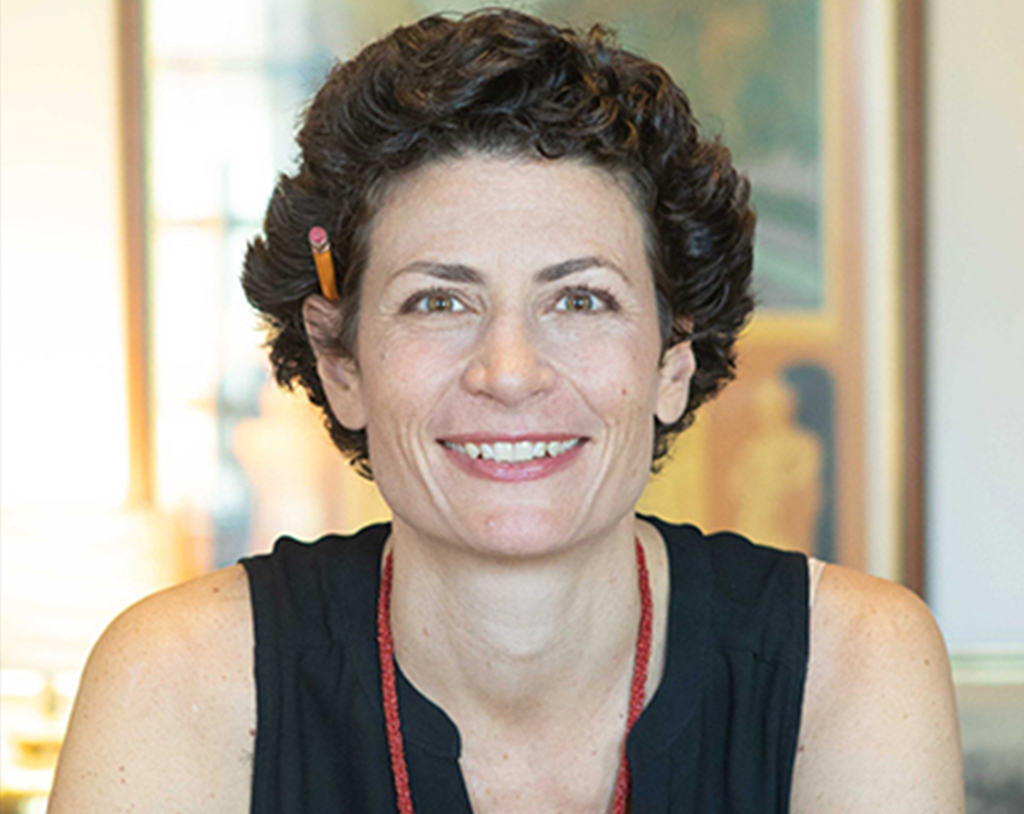
Explore Our Past Shows
